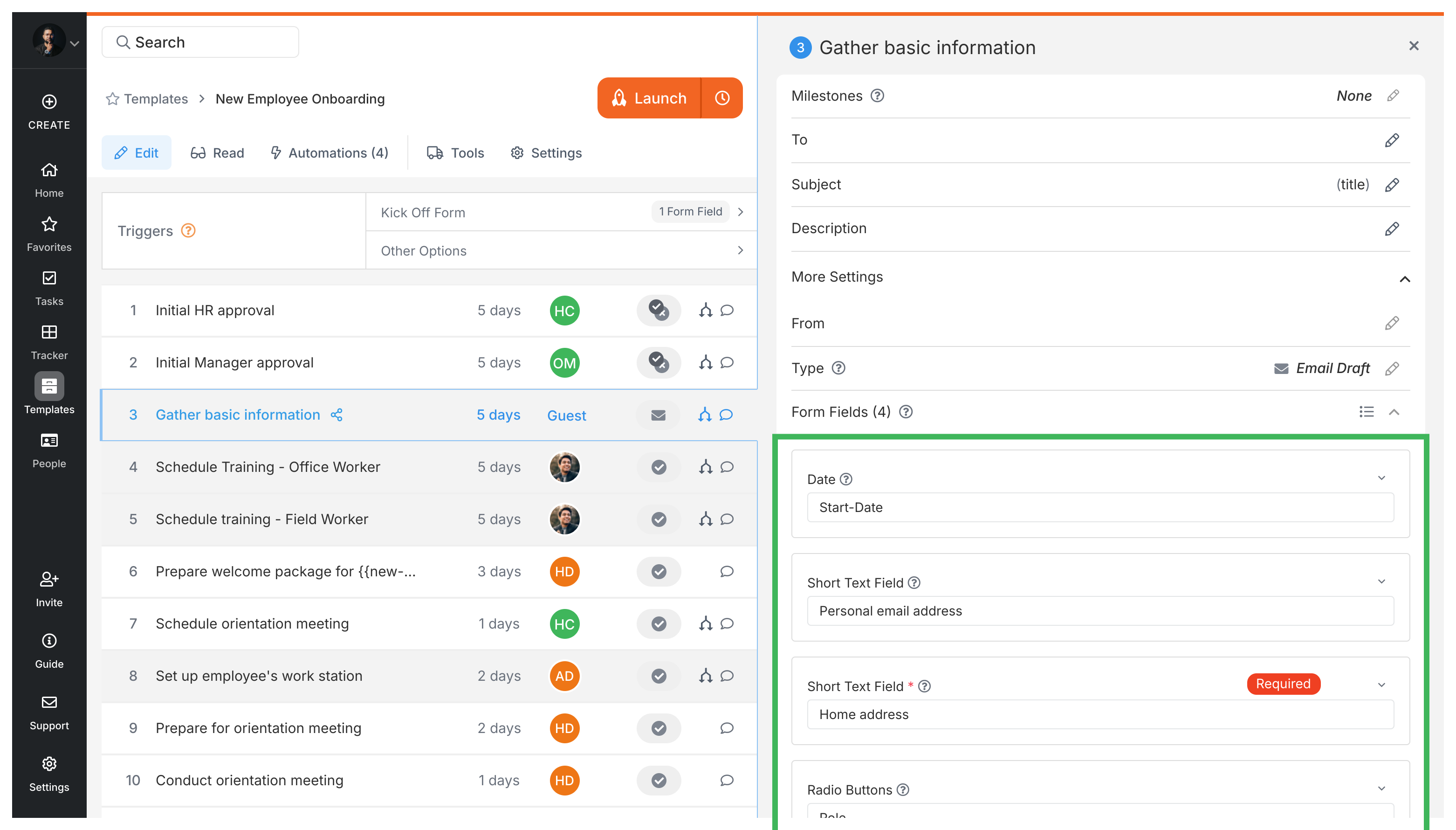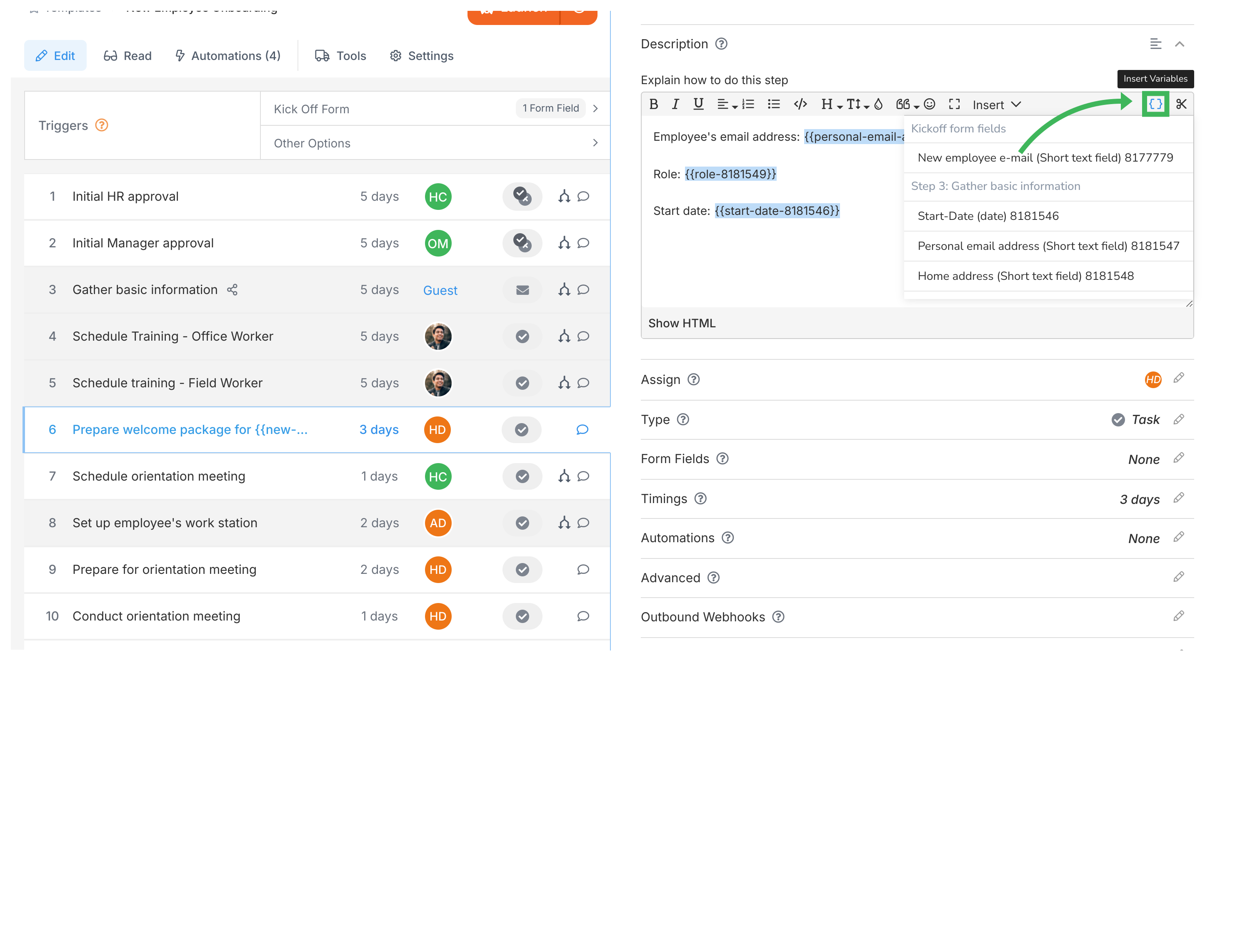Insert variables
To use variables in Tallyfy, click the button in any step title or description and select data from earlier form fields - that’s it. Variables automatically transfer information from one step to another within your process.
Here’s what makes variables powerful: they turn generic workflows into personalized ones. When someone fills out a form field in step 1, you can display that exact information in steps 5, 10, or 20 - without anyone retyping it. Think of variables as smart placeholders that remember what was entered earlier.
- A template open in edit mode
- At least one form field in an earlier step (that’s your data source)
- A later step where you want to display that data
Variables connect your workflow steps like invisible threads. Simple concept:
- Source: The form field where someone types information
- Target: Any step title or description where you want that info to appear
- Format: Variables appear as
{{fieldName}}in curly brackets
When someone fills in the source form field, that exact value pops up wherever you’ve placed the variable. No copying, no pasting - it just appears. Change the source? The variable updates everywhere instantly.
When you click the (Insert Variable) button, you’ll see three types of data to choose from:
-
Kick-off form fields: Info entered when someone first launches the process
-
Form fields from previous steps: Any data entered in steps that come before where you are now
-
System variables: Tallyfy’s own tracking info like:
Current TaskID: The unique ID for this specific taskCurrent ProcessID: The unique ID for this process run- (You might see other system IDs too)
Most users stick to form fields. System variables? They’re mainly for technical integrations1 - like when you need to include an ID in a webhook or API call.
Why use variables? Here’s what you gain:
- Consistency: That client name entered in step 1? It appears perfectly spelled in steps 3, 7, and 15. No typos.
- Live Updates: Change the source data, and watch it update everywhere. Instantly.
- Personalization: Instead of “Review proposal,” your team sees “Review proposal for Acme Corp” - much clearer
- Fewer Errors: Nobody’s copying and pasting (and inevitably making mistakes)
- Context: Important details stay visible throughout the entire workflow
- Open your template in Edit mode.

- Make sure you have a form field in an earlier step to get the data you want to display.

- Go to a step that happens after the step with the form field.
- Click on the step title to edit it.
- Place your cursor where you want the variable information to appear.
- Click the (Insert Variable) button that appears near the title field.
- Select the form field (the source) from the list.
- The variable (like
{{fieldName}}) will be inserted. Save your changes if needed.
- Open your template in Edit mode.
- Ensure the source form field exists in an earlier step.
- Go to a later step and click into its description box.
- Place your cursor where you want the variable information to appear.
- Click the (Insert Variable) button in the text editor toolbar.
- Select the form field (the source) from the list.
7.

- The variable will be inserted. Changes save automatically.
Here’s what happens when your process runs:
- Someone fills out a form field in an early step
- Tallyfy stores that value (don’t worry - it’s secure)
- Later steps with variables automatically show the actual values instead of placeholders like
{{fieldName}} - Need to fix a typo? Update the source field and watch the change ripple through
It’s that straightforward. No magic, just smart data flow.
- “Get approval for Project:
{{projectName}}” - “Review document for Client:
{{clientName}}” - “Schedule meeting with
{{departmentName}}lead”
- “Please review the proposal for
{{clientName}}, focusing on the section about{{focusArea}}.” - “Call
{{customerName}}at{{phoneNumber}}to discuss their order{{orderNumber}}.” - “Prepare the
{{documentType}}based on the request from{{requestingDepartment}}.” - “Upload your documents here:
{{fileRequestLink}}” (useful for file request links from your DMS)
Variables shine when combined with auto-naming. Your processes can name themselves based on the data entered:
- “Onboarding -
{{employeeName}}-{{department}}” - “Support Ticket -
{{ticketNumber}}-{{clientName}}” - “Project Setup -
{{projectName}}-{{priority}}”
Result? Every process gets a meaningful name automatically. No more “Process #12345” confusion.
Want variables that actually work? Follow these practices:
- Name your form fields clearly. “Customer Name” beats “Field 1” every time
- Always test-run your template. Trust me on this one.
- Consider empty fields - if someone skips the “Department” field, will “Contact the lead” still make sense?
- Use variables for anything that changes between process runs (names, dates, amounts)
- Surround variables with context: “Contact
{{name}}at{{phone}}” not just “{{name}}{{phone}}”
Ready to level up? Here’s where variables get really interesting.
Creating adaptive instructions: One template can handle multiple scenarios. No more maintaining 10 slightly different versions of the same process.
Example - Purchase requisition that adapts to amount: Your kick-off form asks for “Purchase Amount”. Then magic happens:
- Step title becomes: “Get approval from
{{approverTitle}}” - Automation rules set
{{approverTitle}}based on the amount:- Under $1,000: “Department Manager”
- $1,000-$10,000: “Division Director”
- Over $10,000: “CFO”
Building personalized checklists: Watch how variables combine with conditional visibility:
- Kick-off form asks: “Which region?” (dropdown: North, South, East, West)
- Instructions say: “Complete the
{{region}}region compliance checklist” - Conditional rules show only that region’s requirements
- One template now does the job of four. Nice.
Dynamic email notifications: Your automated emails can speak directly to each recipient:
- Subject: “Action required:
{{taskName}}for{{clientName}}” - Body: “The
{{documentType}}for{{projectName}}needs your review by{{dueDate}}”
Real emails, real names, real deadlines. Much better than “You have a task waiting.”
Variables showing as raw text instead of values? (like seeing {{clientName}} instead of “Acme Corp”)
This happens when variables lose their connection to the source field. The fix is simple:
- Delete the broken variable text completely
- Click the (Insert Variable) button again
- Re-select the field from the dropdown
- Save your changes
Common causes of broken variables:
- Renaming or deleting the source form field
- Copying template content from another template
- Manual typing of variable syntax instead of using the insert button
- Template import/export operations that disconnect references
Pro tip: Always use the button to insert variables rather than typing them manually. This ensures proper field linking.
Tasks > Set default content for form fields
Edit Processes > Auto-name a process
Tutorials > Create an automation
Was this helpful?
- 2025 Tallyfy, Inc.
- Privacy Policy
- Terms of Use
- Report Issue
- Trademarks